Detrital Zircon Geochronology of the Permian Sedimentary Rocks from the Western Ordos Basin: Implications for Provenance Variations and Tectonic Evolution
Abstract
1. Introduction
2. Geological Setting
3. Sampling and Methodology
4. Results
4.1. Petrographic Features
4.2. Detrital Zircon Morphology and Origin
4.3. Detrital Zircon U-Pb Geochronology
5. Discussion
5.1. Provenance Analysis
5.2. Provenance Variations in the Permian of the Ordos Basin
5.3. Tectonic Implications
6. Conclusions
- (1)
- By comparing the detrital zircon U-Pb ages from the study area with those of potential source regions, it is concluded that the provenance of the Dahuangou Formation in the Youjingshan area was the Alxa Block, while the provenance of the Yaogou Formation was mainly derived from the Yinshan-Daqingshan-Wulashan Orogenic Belt. In contrast, the source areas for both the Dahuangou and Yaogou formations in the Quwushan area were the West Qinling Orogenic Belt and North Qilian Orogenic Belt. It is noteworthy that the two samples from Youjingshan exhibit significant differences in age distributions and peak ages, indicating a pronounced shift in provenance during this period.
- (2)
- The Permian provenance of the Ordos Basin can be classified into three systems: the southwestern system sourced from the West Qinling Orogenic Belt and North Qilian Orogenic Belt; the northwestern system sourced from the Alxa Block and Yinshan-Daqingshan-Wulashan Orogenic Belt; and the interior system primarily sourced from the Yinshan-Daqingshan-Wulashan Orogenic Belt.
- (3)
- During the Permian, the northern margin of the Ordos Basin was influenced by the Paleo Asian Ocean tectonic domain, while its southern margin was affected by the Paleo Tethys Ocean tectonic domain. Due to differences in the timing and intensity of subduction/collision between the Paleo Asian Ocean and the Paleo Tethys Ocean, the paleogeographic pattern of the Ordos Basin exhibited a characteristic “higher in the north and lower in the south” during this period.
Supplementary Materials
Author Contributions
Funding
Data Availability Statement
Acknowledgments
Conflicts of Interest
References
- Lin, C.S.; Xia, Q.L.; Shi, H.S.; Zhou, X.H. Geomorphic evolution, source-to-sink processes and basin analysis. Earth Sci. Front. 2015, 22, 9–20, (In Chinese with English Abstract). [Google Scholar]
- Ju, Y.W.; Wang, W.; Ren, Z.L.; Yang, Z.; Liu, K.Y.; Hou, B.; Xiao, L. Multistage evolution of the Ordos Basin: Basin-mountain coupling system and energy resources. Sci. China Earth Sci. 2025, 55, 2537–2582, (In Chinese with English Abstract). [Google Scholar]
- Zhang, J.; Ma, Z.J.; Ren, W.J. New perspectives on basin-mountain coupling research. Pet. Geol. Exp. 2004, 26, 169–175, (In Chinese with English Abstract). [Google Scholar]
- Liang, J.W.; Ma, X.J.; Tao, W.X. Detrital zircon U-Pb ages of Middle–late Permian sedimentary rocks from the southwestern margin of the North China Craton: Implications for provenance and tectonic evolution. Gondwana Res. 2020, 88, 250–267. [Google Scholar] [CrossRef]
- Tao, H.; Cui, J.P.; Sun, J.P.; Ren, Z.L.; Zhao, F.F.; Su, S.H.; Guo, W.; Song, H.Y. Late Carboniferous to Permian paleoclimatic and tectono-sedimentary evolution of the central Ordos Basin, western North China Block. Mar. Pet. Geol. 2025, 173, 107287. [Google Scholar] [CrossRef]
- Cawood, P.A.; Hawkesworth, C.J.; Dhuime, B. Detrital zircon record and tectonic setting. Geology 2012, 40, 875–878. [Google Scholar] [CrossRef]
- Dickinson, W.R.; Gehrels, G.E. U-Pb ages of detrital zircons in relation to paleogeography: Triassic paleodrainage networks and sediment dispersal across southwest Laurentia. J. Sediment. Res. 2008, 78, 745–764. [Google Scholar] [CrossRef]
- Yang, D.B.; Yang, H.T.; Shi, J.P.; Xu, W.L.; Wang, F. Sedimentary response to the paleogeographic and tectonic evolution of the southern North China Craton during the late Paleozoic and Mesozoic. Gondwana Res. 2017, 49, 278–295. [Google Scholar] [CrossRef]
- Sun, J.; Dong, Y. Stratigraphy and geochronology of Permo-Carboniferous strata in the Western North China Craton: Insights into the tectonic evolution of the southern Paleo-Asian Ocean. Gondwana Res. 2020, 88, 201–219. [Google Scholar] [CrossRef]
- Gehrels, G.E. Detrital zircon U-Pb geochronology applied to tectonics. Annu. Rev. Earth Planet. Sci. 2014, 42, 127–149. [Google Scholar] [CrossRef]
- Meng, Q.R.; Wu, G.L.; Fan, L.G.; Wei, H.H. Tectonic evolution of early Mesozoic sedimentary basins in the North China block. Earth-Sci. Rev. 2019, 190, 416–438. [Google Scholar] [CrossRef]
- Zhao, L.; Zou, Y.; Liu, P.H.; Sun, W.Q.; Zhang, R.C.; Zhou, L.G.; Zhai, M.G. An early Precambrian “orogenic belt” exhumed by the Phanerozoic tectonic events: A case study of the eastern North China Craton. Earth Sci. Rev. 2023, 241, 104416. [Google Scholar] [CrossRef]
- Şengör, A.M.C.; Natal’in, B.A. Paleotectonics of Asia: Fragments of a synthesis. In The Tectonic Evolution of Asia; Yin, A., Harrison, T.M., Eds.; Cambridge University Press: Cambridge, UK, 1996; pp. 486–640. [Google Scholar]
- Yin, A.; Nie, S. A Phanerozoic palinspastic reconstruction of China and its neighboring regions. In The Tectonic Evolution of Asia; Yin, A., Harrison, T.M., Eds.; Cambridge University Press: Cambridge, UK, 1996; pp. 442–485. [Google Scholar]
- Zhao, G.C.; Sun, M.; Wilde, S.A.; Li, S.Z. Late Archean to Paleoproterozoic evolution of the North China Craton: Key issues revisited. Precambrian Res. 2005, 136, 177–202. [Google Scholar] [CrossRef]
- Zhao, G.C.; Wang, Y.J.; Huang, B.C.; Dong, Y.P.; Li, S.Z.; Zhang, G.W.; Yu, S. Geological reconstructions of the East Asian blocks: From the breakup of Rodinia to the assembly of Pangea. Earth Sci. Rev. 2018, 186, 262–286. [Google Scholar] [CrossRef]
- Yang, Q.Y.; Santosh, M. The building of an Archean microcontinent: Evidence from the North China Craton. Gondwana Res. 2017, 50, 3–37. [Google Scholar] [CrossRef]
- Liu, C.Y.; Zhao, H.G.; Gui, X.J.; Yue, L.P.; Zhao, J.F.; Wang, J.Q. Spatiotemporal coordinates of evolution and transformation of the Ordos Basin and its hydrocarbon (mineral) accumulation response. Acta Geol. Sin. 2006, 80, 617–638, (In Chinese with English Abstract). [Google Scholar]
- Zhai, M.G. The Ordos Block: A key to unraveling the mysteries of early continental formation, evolution and tectonic regime in North China. Chin. Sci. Bull. 2021, 66, 3441–3461, (In Chinese with English Abstract). [Google Scholar] [CrossRef]
- He, D.F.; Niu, X.B.; Zheng, N.; Liu, X.S.; Mao, D.F.; Bao, H.P.; Zou, S.; Wei, L.B.; Cheng, C.Y. Types and distribution characteristics of early Paleozoic tectonic differentiation in the Ordos Basin. Acta Geol. Sin. 2024, 98, 3601–3618, (In Chinese with English Abstract). [Google Scholar]
- He, D.F.; Cheng, X.; Zhang, G.W.; Zhao, W.Z.; Zhao, Z.; Liu, X.S.; Bao, H.P.; Fan, L.Y.; Zou, S.; Kai, B.Z.; et al. Scope, nature and exploration significance of the Ordos Basin during geological history. Pet. Explor. Dev. 2025, 52, 757–771, (In Chinese with English Abstract). [Google Scholar] [CrossRef]
- Pastor-Galán, D. From supercontinent to superplate: Late Paleozoic Pangea’s inner deformation suggests it was a short-lived superplate. Earth Sci. Rev. 2022, 226, 103918. [Google Scholar] [CrossRef]
- Critelli, S.; Martín-Martín, M. History of western Tethys Ocean and the birth of the circum-mediterranean orogeny as reflected by source-to-sink relations. Int. Geol. Rev. 2024, 66, 505–515. [Google Scholar] [CrossRef]
- Criniti, S.; Martín-Martín, M.; Martín-Algarra, A. New constraints for the western paleotethys paleogeography-paleotectonics derived from detrital signatures: Malaguide carboniferous culm cycle (betic cordillera, S Spain). Sediment. Geol. 2023, 458, 106534. [Google Scholar] [CrossRef]
- Windley, B.F.; Alexeiev, D.; Xiao, W.; Kröner, A.; Badarch, G. Tectonic models for accretion of the Central Asian Orogenic Belt. J. Geol. Soc. Lond. 2007, 164, 31–47. [Google Scholar] [CrossRef]
- Dong, Y.P.; Santosh, M. Tectonic architecture and multiple orogeny of the Qinling Orogenic Belt, Central China. Gondwana Res. 2016, 29, 1–40. [Google Scholar] [CrossRef]
- Dong, Y.P.; Neubauer, F.; Genser, J.; Sun, S.S.; Yang, Z.; Zhang, F.F.; Cheng, B.; Liu, X.M.; Zhang, G.W. Timing of orogenic exhumation processes of the Qinling Orogen: Evidence from 40Ar/39Ar dating. Tectonics 2018, 37, 4037–4067. [Google Scholar] [CrossRef]
- Chen, R.; Wang, F.; Li, Z.; Evans, N.J.; Chen, H. Detrital zircon geochronology of the Permian Lower Shihezi Formation, northern Ordos Basin, China: Time constraints for closing of the Palaeo-Asian Ocean. Geol. Mag. 2022, 159, 1601–1620. [Google Scholar] [CrossRef]
- Mi, W.; Luo, Y.; Xin, J.; Tai, B.; Ye, X.; Miao, K.; Shang, F.; Zhang, P. Provenance difference analysis of the eastern and western Taiyuan Formation in the northern margin of the Ordos Basin and its tectonic significance. Minerals 2023, 13, 155. [Google Scholar] [CrossRef]
- Yang, C.; Sun, J.P.; Li, Z.L.; Qi, Y.K.; Ye, K.; Zhang, J.X.; Wang, Z.G. Carboniferous-Permian provenance shift in the southeastern Ordos Basin: Tracing early-stage uplift-erosion history of the western Qinling-Dabie orogen. Acta Geochim. 2025, 44, 945–961. [Google Scholar] [CrossRef]
- Liu, C.Y. Weaknesses, difficulties and key points in basin tectonic dynamics research. Earth Sci. Front. 2005, 12, 113–124, (In Chinese with English Abstract). [Google Scholar]
- Zhao, X.C.; Liu, C.Y.; Wang, J.Q.; Zhao, Y. Mesozoic geological events and their evolutionary sequence in the northern part of the North-South Tectonic Belt of China. Geol. Rev. 2018, 64, 1324–1338, (In Chinese with English Abstract). [Google Scholar]
- Du, Y.S.; Zhu, J.; Han, X.; Gu, S.Z. From back-arc basin to foreland basin: Sedimentary basins and tectonic evolution of the North Qilian Orogenic Belt from Ordovician to Devonian. Geol. Bull. China 2004, 23, 911–917, (In Chinese with English Abstract). [Google Scholar]
- Darby, B.J.; Gehrels, G. Detrital zircon reference for the North China block. J. Asian Earth Sci. 2006, 26, 637–648. [Google Scholar] [CrossRef]
- Zhang, Y.Q.; Liao, C.Z.; Shi, W.; Hu, B. Neotectonic evolution of peripheral areas of the Ordos Basin and its regional dynamic background. Geol. J. China Univ. 2006, 12, 285–297, (In Chinese with English Abstract). [Google Scholar]
- Zhang, K.; Zou, H.P.; Liu, Z.H.; Ma, Z.W. Analysis of the Jurassic western boundary of the Ordos Basin. Geol. Rev. 2009, 55, 761–774, (In Chinese with English Abstract). [Google Scholar]
- Zhao, X.C. Mesozoic Tectonic Evolution and Late Transformation of the Northern Part of the North-South Tectonic Belt in China. Ph.D. Thesis, Northwest University, Xi’an, China, 2017. [Google Scholar]
- Zong, K.; Klemd, R.; Yuan, Y.; He, Z.Y.; Guo, J.L.; Shi, X.L.; Liu, Y.S.; Hu, Z.C.; Zhang, Z.M. The assembly of Rodinia: The correlation of early Neoproterozoic (ca. 900 Ma) high-grade metamorphism and continental arc formation in the southern Beishan orogen, southern Central Asian Orogenic Belt (CAOB). Precambrian Res. 2017, 290, 32–48. [Google Scholar] [CrossRef]
- Hu, J.M.; Gong, W.B.; Wu, S.J.; Liu, Y.; Liu, S.C. LA-ICP-MS zircon U–Pb dating of the Langshan Group in the northeast margin of the Alxa block, with tectonic implications. Precambrian Res. 2014, 255, 756–770. [Google Scholar] [CrossRef]
- Liu, Y.; Hu, Z.; Gao, S.; Günther, D.; Xu, J.; Gao, C.; Chen, H. In situ analysis of major and trace elements of anhydrous minerals by LA-ICP-MS without applying an internal standard. Chem. Geol. 2008, 257, 34–43, (In Chinese with English Abstract). [Google Scholar] [CrossRef]
- Liu, Y.; Gao, S.; Hu, Z.; Gao, C.; Zong, K.; Wang, D. Continental and oceanic crust recycling-induced melt–peridotite interactions in the Trans-North China Orogen: U–Pb dating, Hf isotopes and trace elements in zircons from mantle xenoliths. J. Petrol. 2010, 51, 537–571. [Google Scholar] [CrossRef]
- Rubatto, D. Zircon trace element geochemistry: Partitioning with garnet and the link between U–Pb ages and metamorphism. Chem. Geol. 2002, 184, 123–138. [Google Scholar] [CrossRef]
- Belousova, E.; Griffin, W.; O’Reilly, S.; Fisher, N. Igneous zircon: Trace element composition as an indicator of source rock type. Contrib. Mineral. Petrol. 2002, 143, 602–622. [Google Scholar] [CrossRef]
- Jin, Z.; Li, J.Y.; Li, J.F.; Feng, Q.W. Detrital zircon U–Pb ages of Middle Ordovician flysch sandstones in the western Ordos margin: New constraints on their provenances, and tectonic implications. J. Asian Earth Sci. 2011, 42, 1030–1047. [Google Scholar] [CrossRef]
- Li, Z.H. Paleozoic Tectonic Evolution of the Helan Tectonic Belt: Constraints from Detrital Zircon Geochronology. Ph.D. Thesis, Northwest University, Xi’an, China, 2018. [Google Scholar]
- Lease, R.O.; Burbank, D.W.; Gehrels, G.E.; Wang, Z.C.; Yuan, D.Y. Signatures of mountain building: Detrital zircon U/Pb ages from northeastern Tibet. Geology 2007, 35, 239–242. [Google Scholar] [CrossRef]
- Liu, S.P.; Li, J.J.; Stockli, D.F.; Song, C.H.; Nie, J.S.; Peng, T.J.; Wang, X.X.; He, K.; Hui, Z.C.; Zhang, J. late Tertiary reorganizations of deformation in northeastern Tibet constrained by stratigraphy and provenance data from eastern Longzhong Basin. J. Geophys. Res. Solid Earth 2015, 120, 5804–5821. [Google Scholar] [CrossRef]
- Lei, K.Y.; Liu, C.Y.; Zhang, L.; Li, B. Sediment source of the Middle Jurassic Zhiluo Formation in the southern Ordos Basin: Evidence from paleocurrent and detrital zircon U-Pb geochronology. Earth Sci. Front. 2017, 24, 254–276, (In Chinese with English Abstract). [Google Scholar]
- Li, B.; Zuza, A.V.; Chen, X.H.; Wang, Z.Z.; Shao, Z.G.; Levy, D.A.; Wu, C.; Xu, S.L.; Sun, Y.J. Pre-Cenozoic evolution of the northern Qilian Orogen from zircon geochronology: Framework for early growth of the northern Tibetan Plateau. Palaeogeogr. Palaeoclimatol. Palaeoecol. 2021, 562, 110091. [Google Scholar] [CrossRef]
- Chen, Y.; Gan, L.; Wu, T. The Carboniferous-Permian tectonic setting for the southernmost Central Asian Orogenic Belt: Constraint from magmatic and sedimentary records in the Alxa area, NW China. Lithos. 2021, 398, 106318. [Google Scholar] [CrossRef]
- Chen, Y.; Wu, T.; Gan, L.; Zhang, Z.C.; Fu, B. Provenance of the early to mid-Paleozoic sediments in the northern Alxa area: Implications for tectonic evolution of the southwestern Central Asian Orogenic Belt. Gondwana Res. 2019, 67, 115–130. [Google Scholar] [CrossRef]
- Chen, Y.; Wu, T.R.; Zhang, Z.C.; Fanning, C.M.; Zhang, M.M. Provenance of the Permo-Carboniferous sediments in the northern Alxa and its tectonic implications for the southernmost Central Asian Orogenic Belt. Geosci. Front. 2020, 11, 1415–1429. [Google Scholar] [CrossRef]
- Dan, W.; Li, X.H.; Guo, J.; Liu, Y.; Wang, X.C. Paleoproterozoic evolution of the eastern Alxa Block, westernmost North China: Evidence from in situ zircon U-Pb dating and Hf-O isotopes. Gondwana Res. 2012, 21, 838–864. [Google Scholar] [CrossRef]
- Liu, B.; Hao, P.; Wang, G.; Li, P.; Guo, X.J.; Zhang, P.F.; Shi, Z.Q. Provenance of the early Cretaceous sediments in the southern Alxa Area: Implications for tectonic evolution of the south Central Asian Orogenic Belt. Sediment. Geol. 2022, 429, 106083. [Google Scholar] [CrossRef]
- Liu, C.H.; Zhao, G.C.; Liu, F.L.; Shi, J.R. Late Precambrian tectonic affinity of the Alxa block and the North China Craton: Evidence from zircon U-Pb dating and Lu-Hf isotopes of the Langshan Group. Precambrian Res. 2019, 326, 312–332. [Google Scholar] [CrossRef]
- Song, D.; Xiao, W.; Collins, A.S.; Glorie, S.; Han, C.M.; Li, Y.C. New chronological constrains on the tectonic affinity of the Alxa Block, NW China. Precambrian Res. 2017, 299, 230–243. [Google Scholar] [CrossRef]
- Song, D.; Xiao, W.; Windley, B.F.; Han, C.M. Provenance and tectonic setting of late Paleozoic sedimentary rocks from the Alxa Tectonic Belt (NW China): Implications for accretionary tectonics of the southern Central Asian Orogenic Belt. Geol. Soc. Am. Bull. 2021, 133, 253–276. [Google Scholar] [CrossRef]
- Tian, R.; Xie, G.; Zhu, W.; Zhang, J.; Gao, S.; Zhang, B.H.; Zhao, H.; Li, T. Late Paleozoic tectonic evolution of the Paleo-Asian Ocean in the northern Alxa Block (NW China). Tectonics. 2020, 39, e2020TC006302. [Google Scholar] [CrossRef]
- Yin, H.Q.; Zhou, H.R.; Zhang, W.J.; Xu, D.Z.; Li, M.; Jia, Y. Provenance and tectonic setting of the Palaeozoic sediments in the northern Alxa area: Implications for the Central Asian Orogenic Belt. Geol. J. 2020, 55, 1999–2022. [Google Scholar] [CrossRef]
- Zhang, B.H.; Zhang, J.; Zhang, Y.P.; Zhao, H.; Wang, Y.N.; Nie, F.H. Tectonic affinity of the Alxa Block, Northwest China: Constrained by detrital zircon U-Pb ages from the early Paleozoic strata on its southern and eastern margins. Sediment. Geol. 2016, 339, 289–303. [Google Scholar] [CrossRef]
- Zhang, B.H.; Zhang, J.; Zheng, R.; Qu, J.F.; Hui, J.; Zhao, H.; Zhao, S.; Niu, P.F.; Zhang, Y.P.; Yun, L. Paleozoic tectonic evolution of the central part of the southern central Asian Orogenic Belt: Constraints from the detrital zircon U-Pb ages and sedimentary characteristics. Gondwana Res. 2022. 101, 1–20. [CrossRef]
- Zhang, J.J.; Wang, T.; Zhang, L.; Tong, Y.; Zhang, Z.C.; Shi, X.J.; Guo, L.; Huang, L.; Yang, Q.D.; Huang, W.; et al. Tracking deep crust by zircon xenocrysts within igneous rocks from the northern Alxa, China: Constraints on the southern boundary of the Central Asian Orogenic Belt. J. Asian Earth Sci. 2015, 108, 150–169. [Google Scholar] [CrossRef]
- Sun, J.P.; Yang, L.; Dong, Y.P.; Yang, X.Y.; Peng, Y.; Zhao, J. Permian tectonic evolution of the southwestern Ordos Basin, North China: Integrating constraints from sandstone petrology and detrital zircon geochronology. Geol. J. 2020, 55, 8068–8091. [Google Scholar] [CrossRef]
- Jiang, Z.W. Provenance Analysis and Basin-Mountain Coupling Relationship of the Upper Paleozoic Shan 1-He 8 Members in the Southern Ordos Basin. Ph.D. Thesis, Northwest University, Xi’an, China, 2020. [Google Scholar]
- Liang, F.; Huang, W.H.; Niu, J. Provenance analysis of the Shan 1 Member of the Permian Shanxi Formation to the He 8 Member of the Lower Shihezi Formation in the southwestern margin of the Ordos Basin. Acta Sedimentol. Sin. 2018, 36, 142–153, (In Chinese with English Abstract). [Google Scholar]
- Cui, K. Paleocurrent analysis of the Upper Paleozoic Shan 1 and He 8 members in the southwestern Ordos Basin. Groundwater 2019, 41, 142+192, (In Chinese with English Abstract). [Google Scholar]
- Wang, C.Y.; Chen, M.J.; Wang, Z.C.; Guo, H.Y. Sedimentary facies of the Permian Shanxi Formation and He 8 Member of the Lower Shihezi Formation in the southern Ordos Basin. J. Palaeogeogr. 2007, 9, 369–378, (In Chinese with English Abstract). [Google Scholar]
- Li, H.; Li, J.M.; Shi, H. Provenance study of the Lower Permian Shanxi Formation in the southwestern Ordos Basin. J. Oil Gas Technol. 2011, 33, 18–21, (In Chinese with English Abstract). [Google Scholar] [CrossRef]
- Wang, Z.W.; Liu, L.; Hu, J.L.; Li, D.; Chen, H.D.; Zhu, S.Y.; Zhang, C.G.; Zhao, J.X. Spatiotemporal evolution of the early Permian multi-source-to-sink system in the northwestern margin of the North China Block: Implications for the paleogeographic reconstruction along the southern margin of the Paleo-Asian Ocean. Palaeogeogr. Palaeoclimatol. Palaeoecol. 2024, 655, 112500. [Google Scholar] [CrossRef]
- Chen, R.; Wang, F.; Li, Z.; Evans, N.J.; Chen, H.D.; Wei, X.S. Late Paleozoic provenance shift in the east-central Ordos Basin: Implications for the tectonic evolution of the north China Craton. J. Asian Earth Sci. 2021, 215, 104799. [Google Scholar] [CrossRef]
- Tian, W.; Wang, Y.S.; Ma, L.C.; Xin, Y.; Zhang, S.; Zhang, M.H.; Xu, H.Q. U-Pb Age and Geological Significance of Detrital Zircon in the Upper Shihezi Formation Permian System from the Southwestern Margin of Ordos Basin. Acta Mineral. Sin. 2017, 37, 782–790, (In Chinese with English Abstract). [Google Scholar]
- Wang, Z.Q.; Yan, Q.R.; Yan, Z.; Wang, T.; Jiang, C.F.; Gao, L.D.; Li, Q.G.; Chen, J.L.; Zhang, Y.L.; Liu, P.; et al. New division of major tectonic units in the Qinling orogenic belt. Acta Geol. Sin. 2009, 83, 1527–1546, (In Chinese with English Abstract). [Google Scholar]
- Luo, J.L.; Wei, X.S.; Yao, J.L.; Liu, X.S.; Liu, X.H. Control of provenance and sedimentary facies on high-quality natural gas reservoirs of the Upper Paleozoic in the northern Ordos Basin. Geol. Bull. China. 2010, 29, 811–820, (In Chinese with English Abstract). [Google Scholar]
- Bao, H.P.; Shao, D.B.; Hao, S.L.; Zhang, G.S.; Ruan, Z.Z.; Liu, G.; Ouyang, Z.J. Basement structure and evolution of early sedimentary cover of the Ordos Basin. Earth Sci. Front. 2019, 26, 33–43, (In Chinese with English Abstract). [Google Scholar]
- He, D.F.; Bao, H.P.; Kai, B.Z.; Wei, L.B.; Xu, Y.H.; Ma, J.H.; Cheng, X. Critical tectonic modification periods and its geologic features of Ordos Basin and adjacent area. Acta Petrolei Sinica. 2021, 42, 1255–1269, (In Chinese with English Abstract). [Google Scholar]
- Zhang, B.H.; Zhang, J.; Zhao, H.; Nie, F.J.; Wang, Y.N.; Zhang, Y.P. Tectonic evolution of the western Ordos Basin during the Palaeozoic-Mesozoic time as constrained by detrital zircon ages. International Geology Review. 2019, 61, 461–480. [Google Scholar] [CrossRef]
- Li, D.; Zhao, W.B.; Hu, C.; Liu, L.; Hu, J.L.; Wang, Z.W.; Chen, H.D.; Zhu, S.Y.; Zhang, J.Z.; Zhao, F.; et al. Differences in source-sink systems and tectonic-sedimentary framework of the early Permian Shanxi Formation in the southern Ordos area. Acta Sedimentol. Sin. 2023, 41, 1–22, (In Chinese with English Abstract). [Google Scholar]
- Hu, J.L.; Wang, L.L.; Chen, Q.; Huang, D.J.; Liu, L.; Zhang, J.Z.; Wang, Z.W.; Zhu, S.Y. Early-Middle Permian source-sink filling process and tectonic-sedimentary framework in the southwestern Ordos Basin. Nat. Gas Geosci. 2024, 35, 41–58, (In Chinese with English Abstract). [Google Scholar]
- Chen, H.D.; Hou, Z.J.; Tian, J.C.; Liu, W.J.; Zhang, J.Q. Study on sedimentary sequence stratigraphy and basin tectonic evolution of the late Paleozoic in the Ordos area. J. Mineral. Petrol. 2001, 21, 16–22, (In Chinese with English Abstract). [Google Scholar]
- Wei, H.H. Study on Sedimentary Systems and Sequence Stratigraphy of the Carboniferous-Permian in the Ordos Area. Ph.D. Thesis, Northwest University, Xi’an, China, 2002. [Google Scholar]
- Dong, Y.P.; Zhang, G.W.; Neubauer, F.; Liu, X.M.; Genser, J.; Hauzenberger, C. Tectonic evolution of the Qinling orogen, China: Review and synthesis. J. Asian Earth Sci. 2011, 41, 213–237. [Google Scholar] [CrossRef]
- Wang, X.X.; Wang, T.; Zhang, C.L. Neoproterozoic, Paleozoic, and Mesozoic granitoid magmatism in the Qinling Orogen, China: Constraints on orogenic process. J. Asian Earth Sci. 2013, 72, 129–151. [Google Scholar] [CrossRef]
- Li, D.; Liu, L.; Wang, Z.W.; Hu, C.; Chen, H.D.; Zhu, S.Y.; Zhang, R.; Zhao, F. Tectonosedimentary patterns of multiple interacting source-to-sink systems of the Permian Shanxi Formation, Ordos Basin, China: Insights from sedimentology and detrital zircon U-Pb geochronology. Mar. Pet. Geol. 2024, 168, 107034. [Google Scholar] [CrossRef]
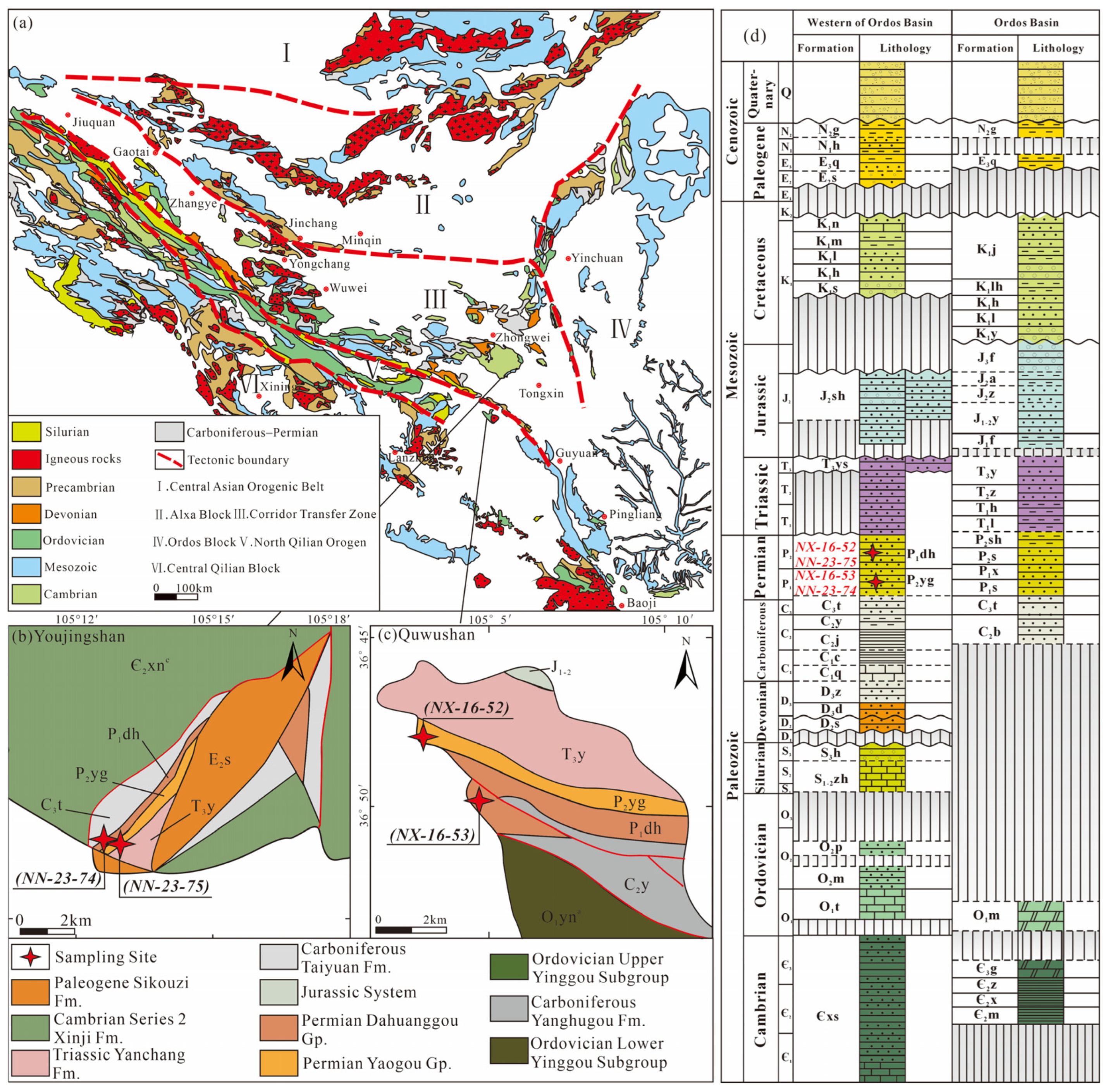

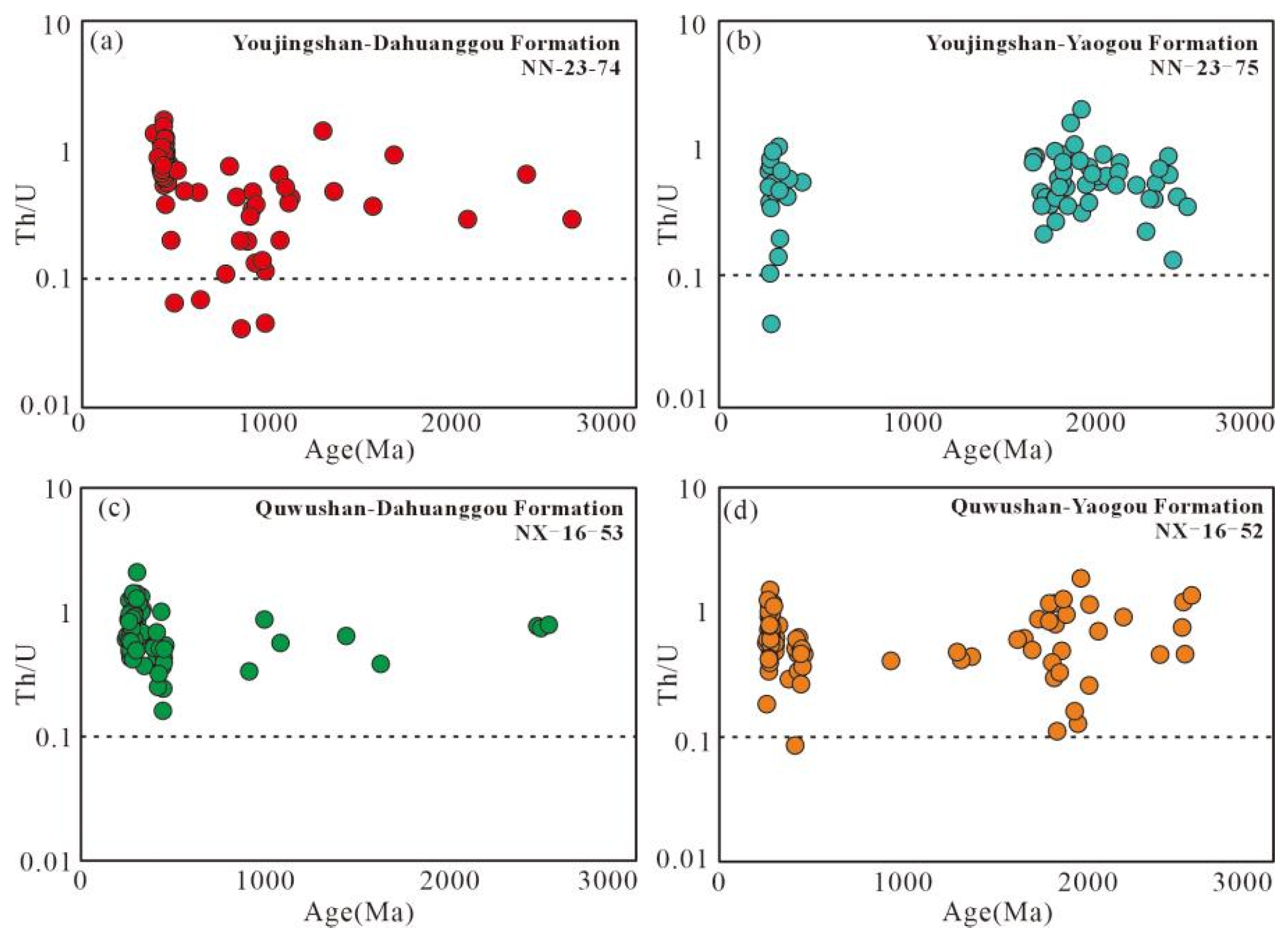

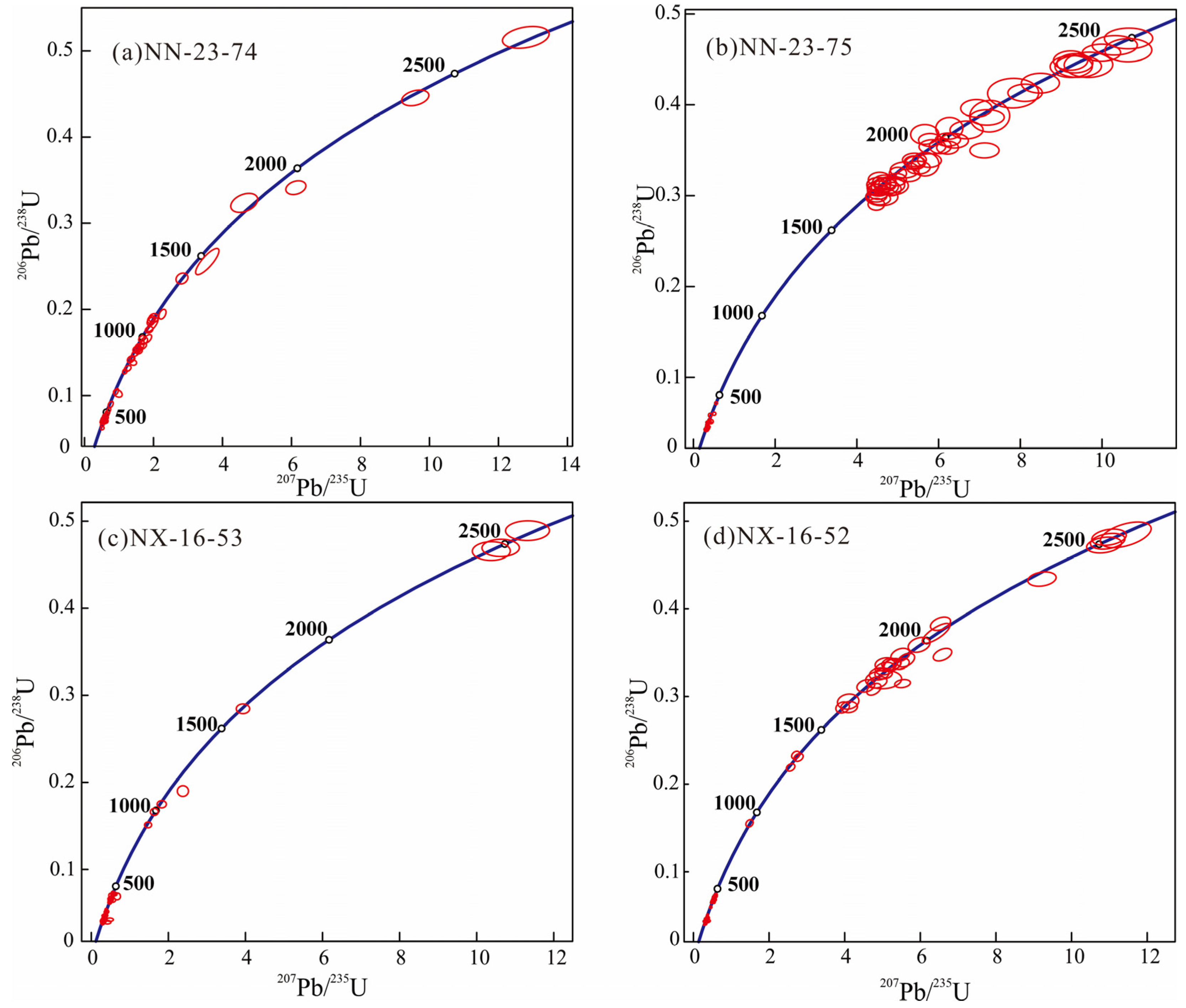



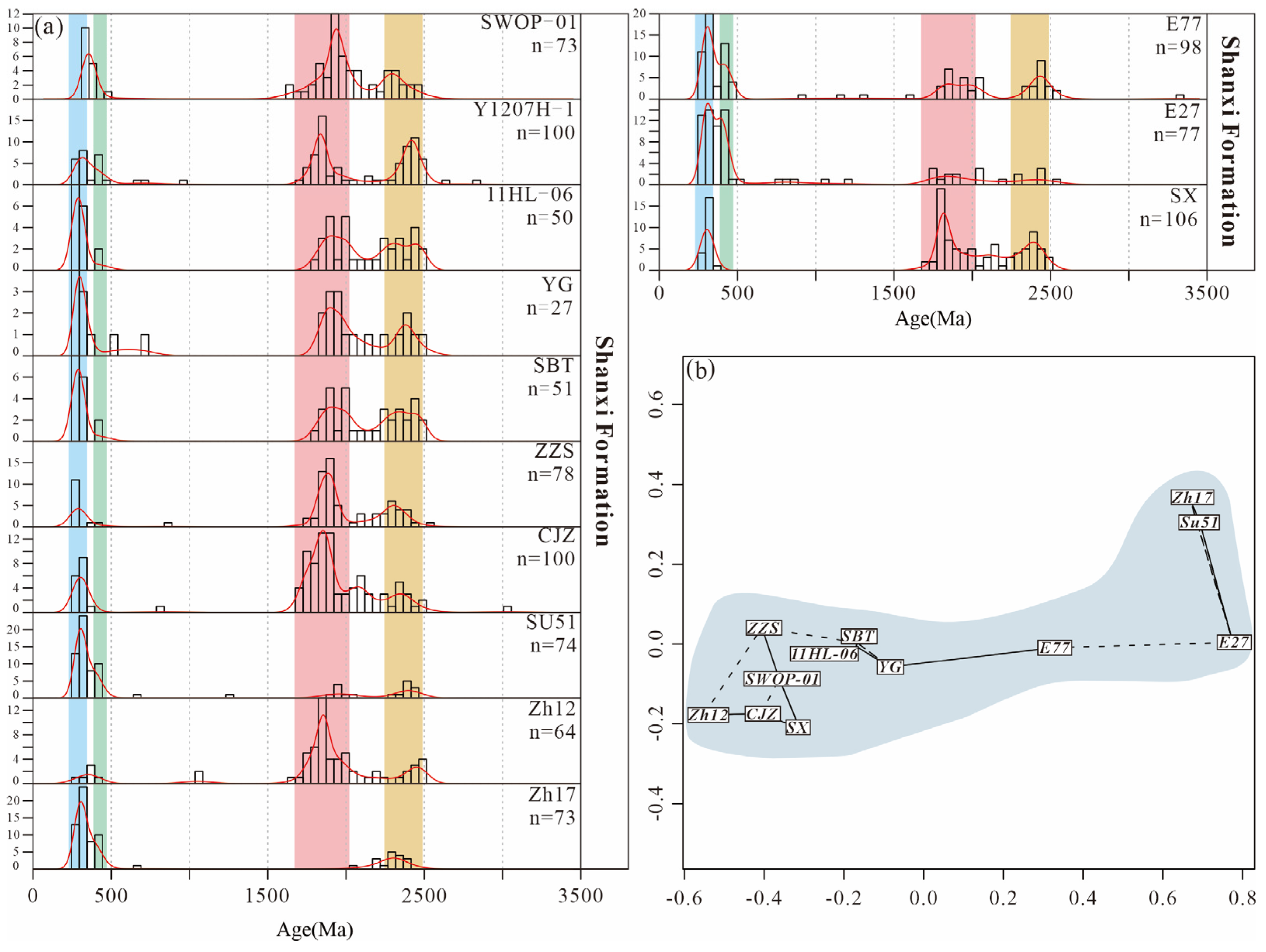
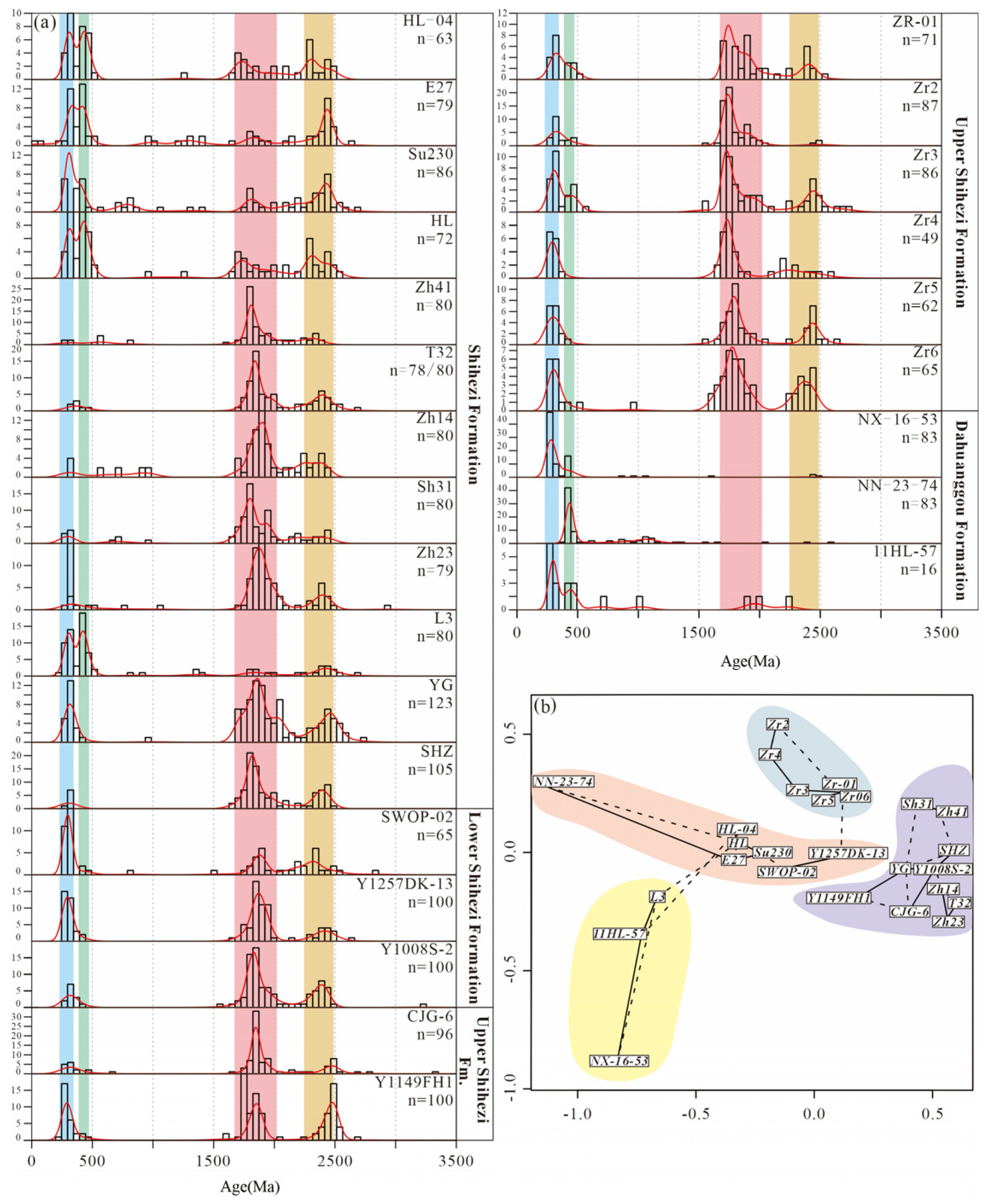
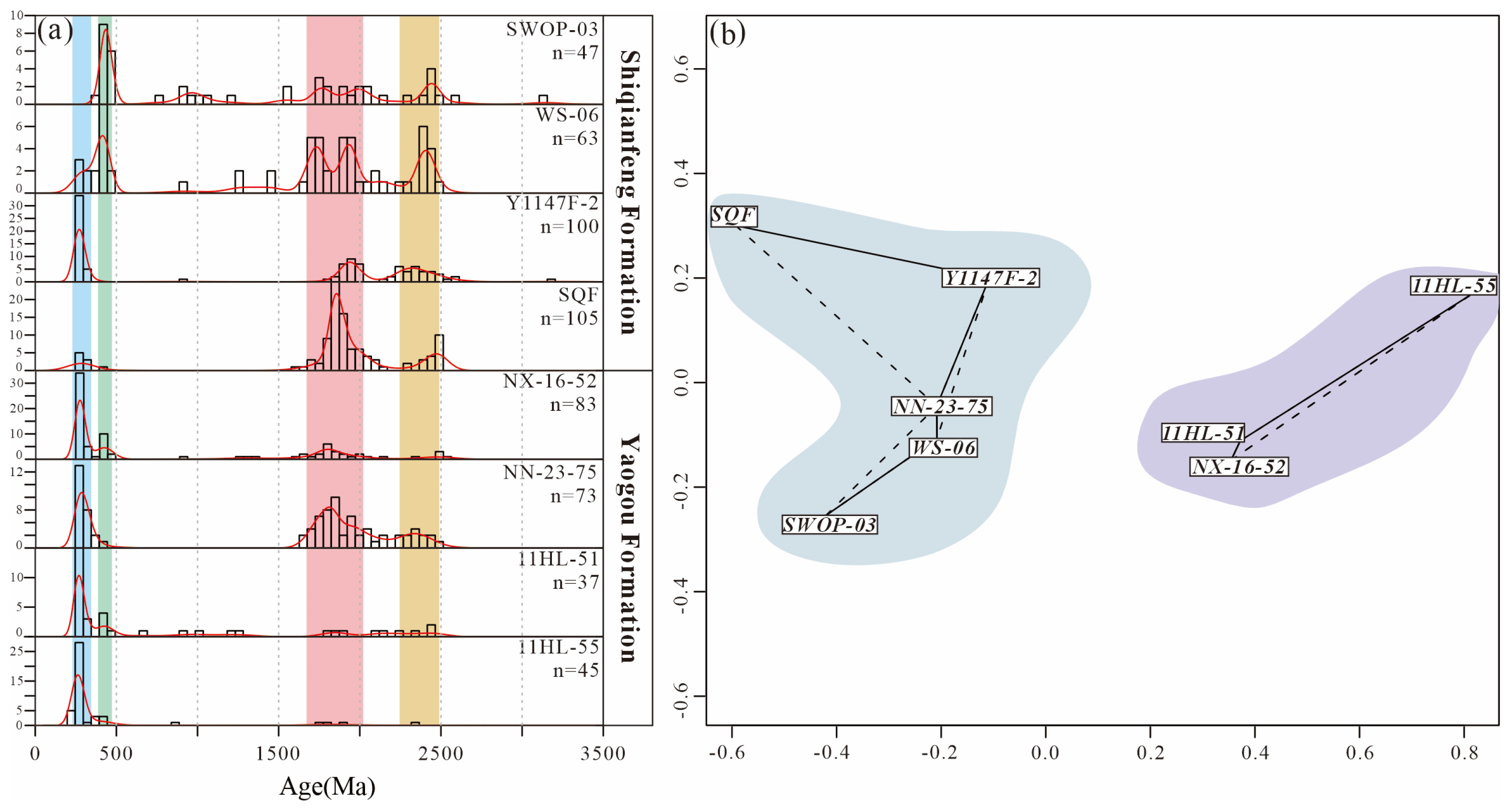

Disclaimer/Publisher’s Note: The statements, opinions and data contained in all publications are solely those of the individual author(s) and contributor(s) and not of MDPI and/or the editor(s). MDPI and/or the editor(s) disclaim responsibility for any injury to people or property resulting from any ideas, methods, instructions or products referred to in the content. |
© 2025 by the authors. Licensee MDPI, Basel, Switzerland. This article is an open access article distributed under the terms and conditions of the Creative Commons Attribution (CC BY) license (https://creativecommons.org/licenses/by/4.0/).
Share and Cite
Zhao, X.; Liu, Y.; Feng, Z.; Chen, Y.; Li, D.; Li, J.; Wei, X.; Ning, Z.; Jiang, Y. Detrital Zircon Geochronology of the Permian Sedimentary Rocks from the Western Ordos Basin: Implications for Provenance Variations and Tectonic Evolution. Minerals 2025, 15, 1233. https://doi.org/10.3390/min15121233
Zhao X, Liu Y, Feng Z, Chen Y, Li D, Li J, Wei X, Ning Z, Jiang Y. Detrital Zircon Geochronology of the Permian Sedimentary Rocks from the Western Ordos Basin: Implications for Provenance Variations and Tectonic Evolution. Minerals. 2025; 15(12):1233. https://doi.org/10.3390/min15121233
Chicago/Turabian StyleZhao, Xiaochen, Yiming Liu, Zeyi Feng, Yingtao Chen, Delu Li, Jintao Li, Xiaoru Wei, Zigang Ning, and Yirong Jiang. 2025. "Detrital Zircon Geochronology of the Permian Sedimentary Rocks from the Western Ordos Basin: Implications for Provenance Variations and Tectonic Evolution" Minerals 15, no. 12: 1233. https://doi.org/10.3390/min15121233
APA StyleZhao, X., Liu, Y., Feng, Z., Chen, Y., Li, D., Li, J., Wei, X., Ning, Z., & Jiang, Y. (2025). Detrital Zircon Geochronology of the Permian Sedimentary Rocks from the Western Ordos Basin: Implications for Provenance Variations and Tectonic Evolution. Minerals, 15(12), 1233. https://doi.org/10.3390/min15121233






